| October
4, 2006
Hello from Nova Scotia: Learning about Native
Heritage at the Bear River First Nation Heritage and Cultural Centre
About an hour after my departure from Annapolis
Royal after a beautiful drive along the shoreline of the Annapolis
Basin and through the early fall colours of the Bear River Valley,
(also known as “Little Switzerland”. I arrived at the
Bear
River First Nation Heritage and Cultural Centre. I was greeted
by Wanda Joudry-Finigan and Robert (Robbie) McEwan, while Frederick
Harlow was manning the cash register. All are members of the Bear
River First Nation, and Wanda and Robbie proceeded to celebrate
my arrival with a special welcome song.
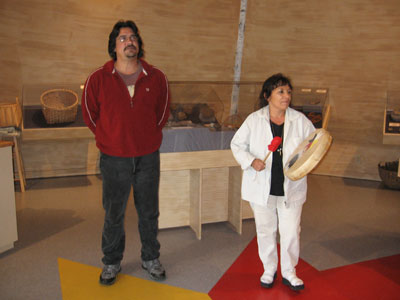
Wanda and Robbie welcome me.
Wanda explained that the song invites our mutual relatives, grandfathers
and ancestors to join us at this occasion. The lobby of the Centre
holds various artifacts and a Heritage Gallery that pays homage
to current and former Chiefs and Elders of the Bear River First
Nation. Wanda pointed out present Chief Frank Meuse Junior who also
operates a lodge for adults and youth alike who wish to learn about
the Mi’kmaq culture. Another image was of Agnes Potter, a
celebrated leader and respected Elder of the Bear River First Nation.
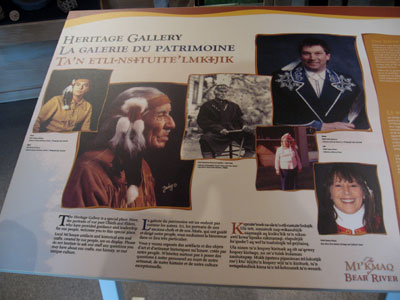
The Bear River Heritage Gallery
Then I was invited to view a brief movie about Willie Meuse, Frank’s
grandfather, shown in footage from the 1930s on the Bear River.
The film also highlighted the construction and launching of the
first birch bark canoe built since 1927. The launching took place
in 2004 and speaks to the importance of the ancestors.
We left the vestibule and entered a large multi-purpose room housing
a variety of interpretive displays about the life and history of
the Mi’kmaq First Nation. This room is also used for theatre
productions, games of sports for the youth, community card parties,
holiday feasts and presentations. Frederick joined me and gave me
an overview of the birch bark canoe. He explained that the canoe
weighs about 90 to 95 pounds and was constructed using authentic
historical canoe-building methods used in the area. The canoe is
a sea-going canoe, evidenced by the high rise in the middle. Fresh-water
canoes do not feature a rise in the middle of the canoe.
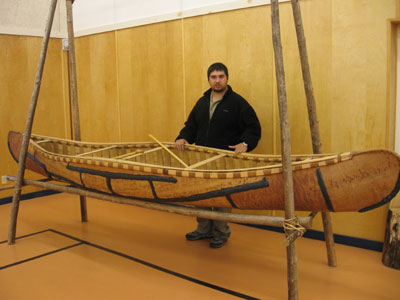
Frederick shows me the birch bark canoe
The vessel is constructed of various types of wood including ash
and birch and the outside is covered with birch bark. Any potential
openings in the canoe’s skin are patched up with a mixture
of spruce gum and bear grease. Canoes used to be the main form of
transportation for the First Nations People and their navigation
skills, fishing and hunting knowledge helped the French settlers
when they first came to this area in the 1600s. This life-size canoe
was made by Todd Labrador and Cory Ryan who is a seventh generation
descendent of Malti Pictou, a well-known Bear
River Mi’kmaq guide. Before Cory, he was the last person
to make a birch bark canoe in the area.
The next exhibit featured a variety of arts and crafts that are
produced here using Mi’kmaq artistic traditions. Robbie came
over to give me more insight into some of the local arts and crafts.
He explained that leather is worked to produce mittens, jackets,
dresses, moccasins and other items. Dreamcatchers are an important
symbol to the Mi’kmaq. With their intricate web-like design
they are hung to catch dreams floating through the night air. There
is a saying that dreamcatchers let the good dreams through but protect
you from the bad dreams.
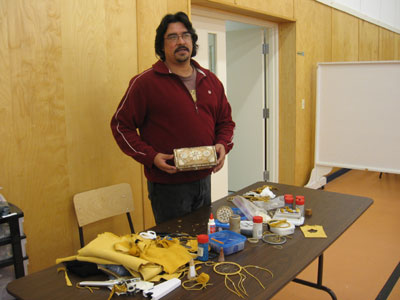
Robbie explains the various arts and crafts
Jewellery is made using a variety of glass beads, bone beads as
well as imitation sinew. In the past moose tendons were used to
produce the pendants and bracelets. Decorated deer and moose hide
are available for purchase as well. Robert indicated that he recently
made an ornate dress for a native chief in Newfoundland. His artistic
skills are evidenced by some of the most impressive pieces of work:
Robert showed me a decorative jewellery box that he is currently
working on. The box is made of birch bark and porcupine quills,
bordered with sweet grass whose scent I was able to smell. He explained
that porcupine quills are easily removed from the animal, and they
are essentially used to stitch an elaborate design. For each quill
a hole is poked and the quill is pulled through. By the time this
item is finished, Robert will have invested over 200 hours to produce
the elaborate pattern on this decorative box.
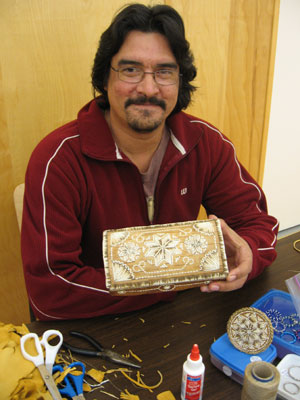
A beautiful birch bark box with porcupine quills
Wanda joined us and took me to a display of a wigwam to explain
certain rituals and conventions that would be adhered to in First
Nations encampments. Visitors would be invited to sit in the most
honourable space in the home or wigwam. The same would go for children
so they would be able to see everything to the left and to the right
of them in order to be able to learn. During winter mats made from
rush would be used for insulation against the cold. Baskets were
hand- made in order to harvest scallop, clams, or mussels. Each
of these particular baskets could hold up to 10 pounds of seafood.
Other baskets made from ash were used for potato and apple picking.
These baskets were hand-made in large quantities in the 1900s as
a major means of economic survival in changing times. Today these
baskets are sold as decorative items.
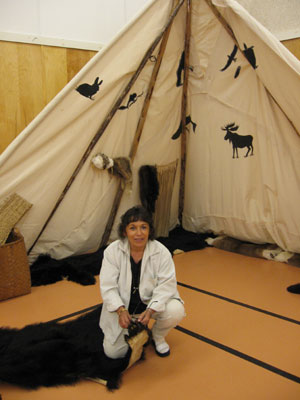
Wandy shows me the sharp claws of a bear
The tipi also features a variety of furs, including lynx, rabbit,
mink, red fox and silver fox. During the 1920s and 1930s silver
foxes were a real fashion craze in England and many women had a
fox fur, complete with head and legs, draped around their necks
as a statement of elegance. The fox’ head would be equipped
with a clasp so it could be clipped onto the lapel of the lady’s
coat.
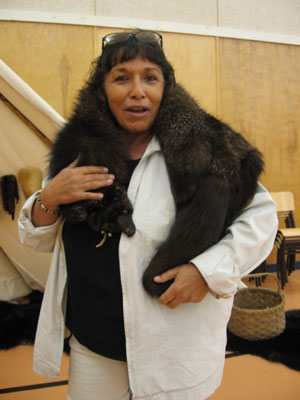
A silver fox worn around the neck, a big fasion item in the 1920s
and 1930s
I learned that the wigwam is made of birch bark. Wigwams were lightweight,
which made them easy to move from one location to another and water-resistant.
Encampments would be set up near the mouth of rivers, which would
provide a plentiful opportunity for food and means of travel. A
large part of native diet consisted of fish; the rest was made up
of berries, fruits and meats. Often fishing weirs were used for
catching eels. Wanda explained that in the last few years about
800 encampments have been found in Nova Scotia with more than 4000
artifacts dating back 2,500 to 4,000 years.
Mi’kmaq hunting traditions included bear traps that were baited
with fish. Once the animal was caught, women would remove the guts,
the hide and the sinews and carry it back to the camp to prepare
it. Excess meat and fat would be scraped off the skin with scraping
tools, stones or shells. Wanda informs me that women were very highly
respected in First Nations society, as they were life givers. Meals
were cooked in a hollowed-out log that held red-hot stones that
had been heated over a fire. Water would be poured over the food
and the hot stones to cook the meal. Spices were gathered in the
forest, and instead of potatoes a plant called the Jerusalem artichoke
would be served with the meat. Fish and meat were dried or smoked,
and eggs were gathered from marsh birds.
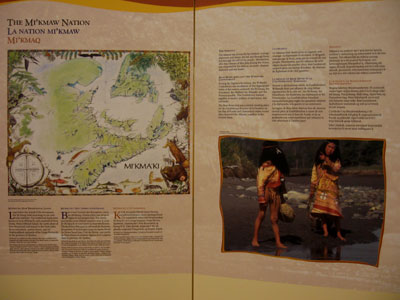
Information about the Mi'kmaq Nation
We moved over to a display on Mi’kmaq language and Wanda
mentioned that there were 7 Mi’kmaq districts, each with their
own chief. The Bear River Reservation is located in a place called
“Kespukwik”, meaning “where the water stops flowing”,
referring to the Bear River flowing into the Annapolis Basin. Mi’kmaq
language is based on action verbs, and pronouns are important indicators
of belonging and possession. For instance, the words “mother”
or “sister” can never be said by themselves, they always
require a pronoun to indicate whose mother we are talking about.
The Mi’kmaq words would say “your mother”, “my
mother”, or” his/her mother” etc.
At the next display we saw a 1936 picture of Wanda’s great-grandmother,
Sarah Fossey who lived until 1961 to the ripe old age of 101. Wanda
has fond memories of Sarah who used to bring her grandchildren and
great-grandchildren oranges as a special treat. Sarah was captured
in a movie from the 1930s that was displayed at the Bear
River First Nation Heritage and Cultural Centre. Wanda was overwhelmed
when she first saw moving images of her great-grandmother in the
movie.
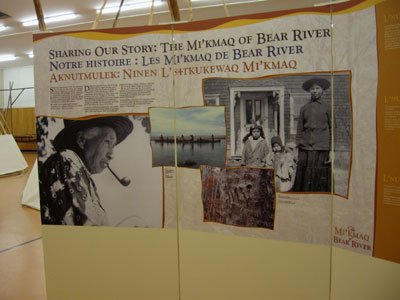
Wanda's great-grandmother Sarah Fossey is pictured on the left
We also discussed life as a Mi’kmaq today. Wanda explained
that Mi’kmaq society was matriarchal until the arrival of
the first Europeans. In recent years, from the 1920s to the 1990,
the government instituted a policy of residential schools where
young native children were taken away from their families and taught
the “white man’s ways’. This led to a significant
loss in culture and heritage, women’s status eroded as a result
and Mi’kmaq family structure suffered. The government wanted
to force native children to “integrate” into mainstream
society and in the process an ancient way of life was destroyed.
Siblings were often not allowed to talk to one another and families
were torn apart. Many of the native children suffered from mental,
physical and sexual abuse in the residential schools. As a result
of these policies, today many elders are learning the Mi’kmaq
language from the younger generation.
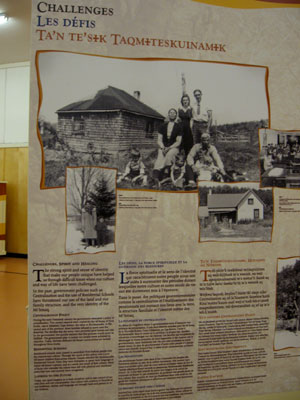
The challenges of the Mi'kmaq people
Today there is a counter-trend where young First Nations people
are rediscovering their language, culture and heritage. Of the conditions
at the Bear River Reservation Wanda says that it is a managed forest
and there is no poverty on the reserve, which holds about 100 people.
Wanda herself has lived off the reserve for her entire life and
has been self-efficient.
Wanda also explained that having “native status” is
an important issue in First Nations communities. Native status confers
certain benefits in terms of health care, taxation and schooling.
Bill C31, introduced in 1985, improved native women’s status
in the sense that they could pass native status on to their first
generation children, even if the children were from a mixed native/non-native
marriage. Men on the other hand can pass on native status indefinitely
through the generations, even if they marry a non-native wife. This
often creates economic inequality and friction within the same family
where one set of cousins could have native status whereas another
cousin would not officially be considered native. Even fairly recent
legislation prolongs the European tradition of favouring male bloodlines.
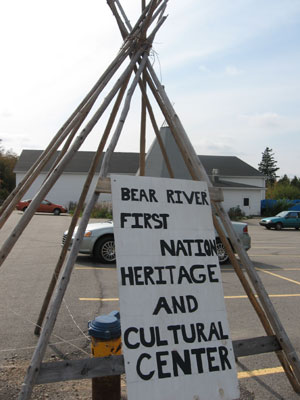
Welcome to the Bear River First Nation Heritage and Cultural Center
Wanda gave me the names of several books that would provide further
education about First Nations life and communities and when I said
goodbye, she generously gave me two books to read as a present:
“L’sitkuk – The Story of the Bear River Mi’kmaw
Community” by Darlene Ricker, and “We Were Not Savages – A Mi’kmaq Perspective on the Collision between European
and Native American Civilizations” by Daniel N. Paul, excellent
reading material to educate myself further about native culture
and history. As a parting gift she gave me a handcrafted medicine
pouch that she had made herself, an example of the Mi’kmaq
tradition of generosity and peacefulness.
I thanked Wanda and the entire team at the Bear
River First Nation Heritage and Cultural Centre for their most
interesting introduction to Mi'kmaq heritage and culture and resolved
to read these books soon to educate myself. I started driving down
the hill and all the people congregated at the local Bear River
Band Office waved goodbye to me. It was time for me to continue
my drive along the Evangeline Trail
to tonight’s final destination: Yarmouth.
Useful books about travel to Nova Scotia:
Related articles:
My five whirlwind days in Nova Scotia
Acadian
history at the Grand Pré National Historic Site
400 years of history at Annapolis
Royal
Port-Royal, a French habitation from 1605
Dinner at the Garrison House
in Annapolis Royal
The Annapolis Royal
Graveyard Tour
The Garrison House Bed and Breakfast
Exploring the Evangeline Trail from
Annapolis Royal to Yarmouth
Learning about Mi'kmaq heritage at the
Bear River First Nation Heritage and Cultural Center
Victorian heritage in Yarmouth
The MacKinnon-Cann Inn: Where Home
and Garden Television meets the Travel Channel
Yarmouth explained - the Yarmouth
County Museum
My car is in the ditch in Chebogue
River
The Lighthouse Trail from Yarmouth
to Shelburne
The Lighthouse Trail from Shelburne
to Lunenburg
The Town of Lunenburg - a UNESCO World Heritage
Site
An interview with the owners of the
Lunenburg Inn
The Lighthouse Trail from Lunenburg to
Halifax via Mahone Bay and Peggy's Cove
Arrival in Halifax and a stunning
musical performance - DRUM!
A Halifax city tour, the city's
connection to the Titantic and the 1917 Halifax Explosion
Exploring the Halifax Harbourwalk and
Pier 21 - Canada's immigration museum
A ferry trip to Dartmouth and saying
goodbye to Halifax
An interview with Pier 21 -
Canada's immigration museum
Helpful links for travel to Nova Scotia:
Tourism
Nova Scotia
Destination
South West Nova Scotia
Halifax Tourism
|